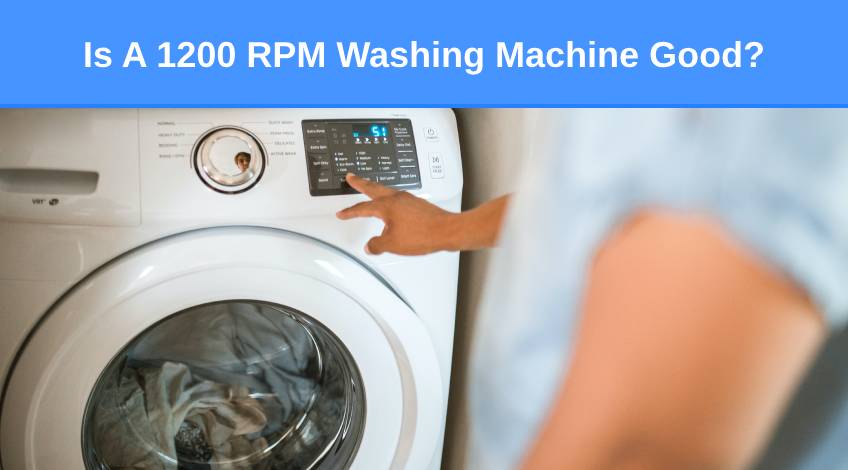
Is A 1200 RPM Washing Machine Good?
If you’re looking to buy a new washing machine, you will have noticed that there’s a lot of choice. Many manufacturers focus on the spin speed as a major selling point. But does a high spin speed really make that much difference?
In this article we take a look at common top spin speeds of washing machines and find out just how important they really are and ask the question is 1200 RPM good enough on a washing machine? And much more besides.
What Is The Spin Speed Of A Washing Machine?
One of the main selling points on modern washing machines apart from the various programmes and cycles is the spin speed. But what does “spin speed” mean?
The spin speed is how many times per minute the drum rotates during the spin cycle on the washer. This is quoted as RPM which stands for Revolutions Per Minute. Which means that if you see 1200 RPM on the blurb for a washing machine it’s letting you know that the top spin speed for that particular appliance’s drum is 1,200 revolutions a minute.
Why Is The Spin Speed Important?
The spin speed of the drum on a washing machine is important because it determines how much water is removed from the laundry as it gets exposed to centrifugal force.
The higher the spin speed, the more water is extracted from the spinning laundry and the drier the clothes will be after the cycle has finished.
However, there comes a point when the difference in spin speed affects the moisture content of the laundry less. You see, scientists worked out a long time ago that the amount of water extracted from clothes after the speed reaches 1200 RPM is far lower than is seen at lower levels.
The easiest way to explain this clearly is to show you the following table;
| Spin Speed (RPM) | Remaining Moisture Level (%) |
|---|---|
| 1800 RPM | 42% |
| 1600 RPM | 44% |
| 1400 RPM | 50% |
| 1200 RPM | 53% |
| 1000 RPM | 60% |
| 800 RPM | 70% |
| 400 RPM | 90% |
As can be seen from the above table, there’s a significant difference between the remaining moisture levels between 400 RPM and even 800 RPM compared to 1200 RPM.
However, the difference between 1200 RPM, 1400 RPM and 1600 RPM is negligible by comparison and only increases by a few percent. Whereas the differences in moisture between the slower spin speeds increases at a rate of around 10% per 200 RPM increase.
But That Spin Speed Is Not Maintained Throughout The Whole Cycle
Another point worth mentioning is the fact that washing machines rarely maintain the high spin speed for long anyway. In the majority of cases a washing machine doesn’t remain at the maximum velocity.
A washing machine spinning at a 1400 RPM spin speed for example, will take time to build up to 1400 revolutions per minute, it remains at that top speed for around 30 seconds and then slowly starts to decrease its rate of spin.
WIth large loads, there’s a good chance that the high spin speed won’t be achieved at all.
What Are The Benefits Of Lower Spin Speeds?
We have all been led to believe that a high spin speed is necessary to get our clothes dry. As we’ve seen, this is true, up to a point. However, spin speeds greater than 1200 RPM don’t really extract that much more in the way of moisture.
There is a difference sure, but it’s minimal, so what are the benefits of lower spin speeds?
- Lower Purchase Price
Washing machines with higher spin speeds almost always have a higher purchase price. - Less Noise
Lower spin speeds tend to make the washer vibrate less which in turn, means less noise. - Washing Machine Lasts Longer
As the washer is under less pressure, its component parts will typically last longer. - Reduced Creases In Laundry
Clothes tend to not get as creased or wrinkled at lower spin speeds. - Less Wear & Tear To Fabrics
Lower spin speeds reduce the risk of stretching, tearing, pilling or other damage to clothes.
That doesn’t mean it’s not worth buying a machine with a higher spin speed if that’s what you want. Obviously, the difference between a 1200 RPM and a 1800 RPM washer is around 9% less moisture content.
And although this is quite significant, most people would hardly notice it.
Why Do Washers With Higher Spin Speeds Cost More?

We’ve just seen that washing machines with a spin speed greater than 1200 RPM don’t get laundry significantly drier. However, the higher spin speed washers are typically more expensive to buy.
You would assume that’s because of the need for different components. But that’s not the case, in the majority of cases a washing machine with a 1600 RPM spin speed will have exactly the same parts and components as a washer with a 1200 RPM spin speed.
So Why Do They Cost More?
The reason for the dearer price tag on a faster spin speed washer is that the public assume it’s a better machine and are willing to pay more for it.
From a technical point of view, the washers are pretty much identical. The same size drum, same design and you might be surprised to learn, the same motor. The only difference is the washer with the top spin speed of 1200 RPM has been regulated to cut off if it spins any faster.
This means the appliances have almost identical production costs and the only difference is the way the public perceives value. High spin speeds are seen as extra features and extra features cost more money.
Let’s face it, if the same make and model washer with a higher spin speed cost the same price, we’d most likely think there was something wrong with it. This leads to 1200 RPM washers costing more than 1000 RPM models and 1400 RPM washers costing more than 1200 RPM models.
In our opinion, the moisture reduction achieved at 1400 RPM or 1600 RPM isn’t significant enough to justify the extra cost. We would go for a 1200 RPM spin speed and save what could be as much as £200.
What Are The Recommended Spin Speeds For Fabrics?
Once you select a wash programme on your washer, it sorts out the temperature, duration and spin speed. Most of the time these preset programmes are perfect for the type of clothes you’re washing.
For example selecting the cotton wash will use a higher spin speed than a delicate wash. While a synthetic wash will use a lower spin speed than a cotton wash.
That doesn’t mean that you can’t manually adjust the spin speed if you want to. For instance, when washing delicate fabrics, you might want to reduce the spin speed to prevent any damage to your garments.
Below is a table showing the recommended spin speeds for various fabrics to prevent damage.
| Fabric Type | Spin Speed (Recommended) |
|---|---|
| Cotton | 1200-1400 RPM |
| Denim | 800-1000 RPM |
| Synthetics | 800-1000 RPM |
| Wool | 600 RPM |
| Delicates (silk etc) | 400 RPM |
Cotton (1200-1400 RPM)
Cotton is a robust fabric and can withstand higher spin speeds. 1200 or even 1400 RPM will not damage the cotton fibres. The extra spin speed will help to remove more moisture and dry your cotton clothes faster.
Denim (800-1000 RPM)
Denim, like cotton, is known for absorbing a lot of water during the wash and rinse cycle. Which means a relatively high spin speed is necessary to remove excess moisture.
However, denim isn’t quite as tough as its reputation and could shrink if treated to high spin speeds which is why 1000 RPM is the maximum recommended spin speed for denim.
Synthetics (800-1000 RPM)
Synthetic fibres are typically quite robust and can often be spun at higher speeds than many natural fibres. You’ll need to check the wash care label, but there are some synthetics that can be spun at 1200 RPM without any risk of damage.
Wool (600 RPM)
Wool is a natural fibre and is prone to shrinking and felting if treated too roughly. That is why the highest recommended spin speed for wool is 600 RPM.
Silk & Other Delicate Fabrics (400 RPM)
These materials often are hand wash only due to their delicate nature. This means they need to be handled gently and in many cases, should be air dried only. However, some delicates can be spin dried but only at the lowest spin speed to avoid any damage.
Please Note: All of the above are only for guidance purposes, check the wash care label and the instructions in your user manual for specific advice.
What About The Spin Speed On Top Loaders?
Compared to front loader washing machines, top loaders have lower spin speeds. The spin speeds of top loader washing machines with agitators is anywhere between 650-1400 RPM.
A top loader with a spin speed of 850 RPM or above is considered to be good. There are some top loaders that have higher spin speeds. Whirlpool, for instance, make a top loader with a 1400 RPM spin speed.
So, Is A 1200 RPM Spin Speed Any Good For A Washing Machine?

After looking at all of the facts, and weighing up the pros and cons, we would have to say, yes, a 1200 RPM spin speed washer is good. Even though many people buy washers that have 1400, 1600 and even 1800 RPM spin speeds, these are not really necessary.
As we saw earlier, any spin speed greater than 1200 RPM doesn’t really achieve a much greater level of dryness. The extra cost of the appliance isn’t typically caused by a better machine, only market forces.
Plus 1200 RPM is gentler on your clothes and higher spin speeds only typically run for a maximum of 30 seconds anyway. The rest of the spin cycle time is taken getting up to the maximum spin speed or slowly decreasing the spin speed.
There are more important things than spin speed that need to be considered when buying a new washing machine. As long as the appliance you choose has a spin speed of at least 1200 RPM, your laundry will be around half way dry on leaving the machine.
SEE ALSO: What Spin Speed Should You Use On A Washing Machine? (the ultimate guide)
Frequently Asked Questions
When it comes to spin speeds of washing machines and how much moisture is extracted, the difference between a 1200 RPM and a 1400 RPM is minimal. However the purchase price of the washer with a higher spin speed could be considerably more.
A spin speed of 1200 RPM should get your clothes almost 50% dry. This might mean they’re slightly damper than those spun at 1400 or 1600 RPM but the fabrics will last longer due to the gentler spin speed.
High spin speeds are needed to dry thicker, more robust fabrics like cotton and denim. However, delicate fabrics like silk, wool etc would become damaged at high spin speeds. Also, higher spin speeds are likely to cause more wear and tear on all garments regardless of the fabric they’re made from.




